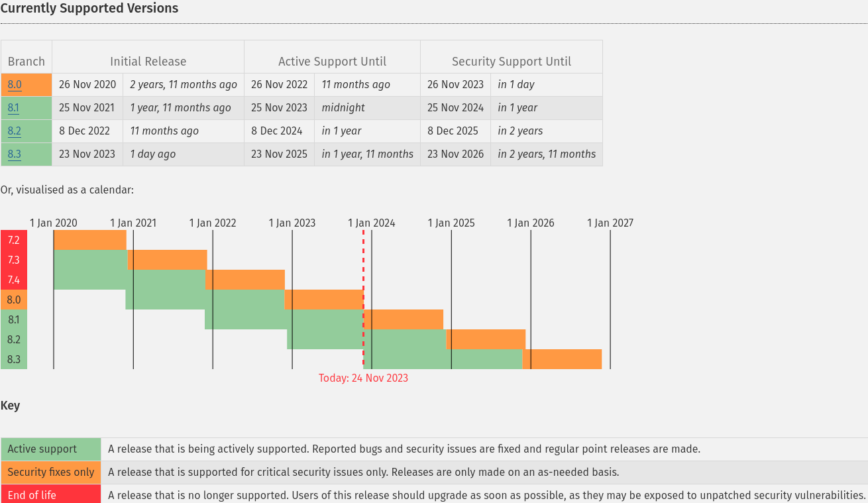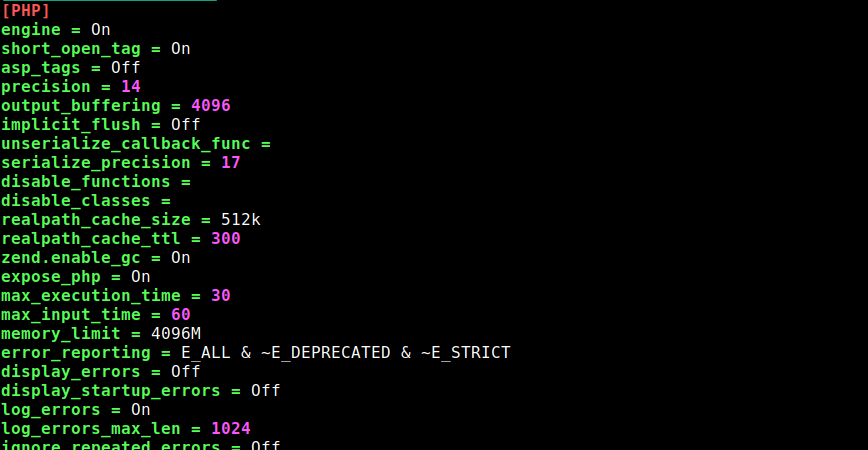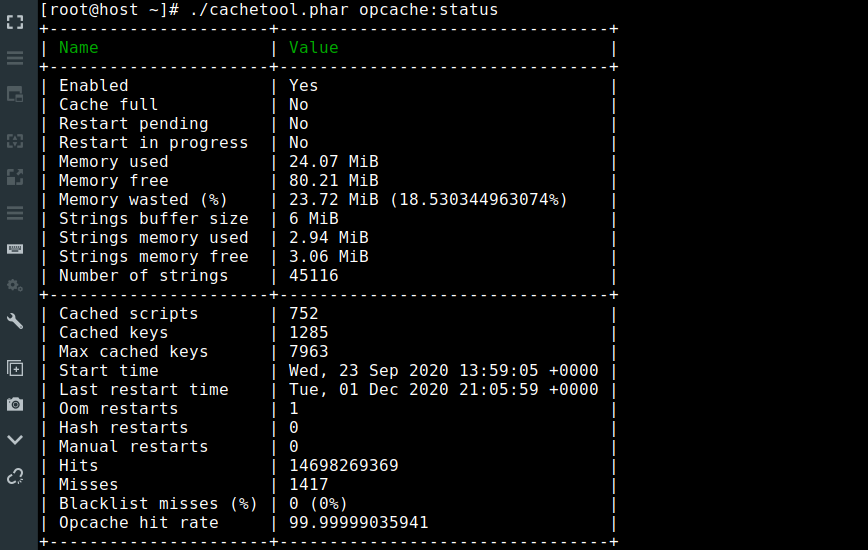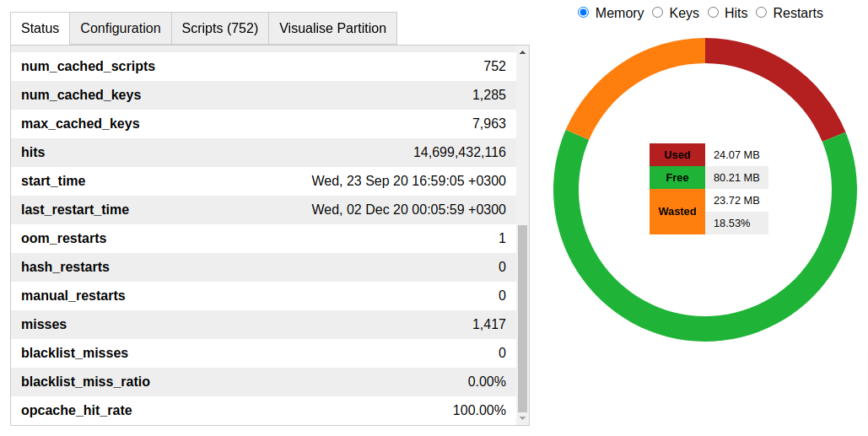PHP 8 Compatibility Check and Performance Tips
PHP 7 was first released back on 03 Dec 2015. It’s been around a while! The PHP team encouraged upgrading to PHP 7, hailing its improvements such as being twice as fast, consistent 64-bit support, removing old and unsupported SAPIs and extensions, and improved fatal error resistance, to name a few.
A few years ago, I wrote the short article 80% of the web powered by PHP. [But 90% of PHP sites run PHP5]. Since then, we’ve had some movement on this front; PHP 7 now accounts for more than 60% of installed PHP versions and PHP still holds 80% 76% market share of server-side programming languages for websites.
At the end of 2021, PHP 7.4 lost active support. So, what are your thoughts? Have you performed a PHP 8 Compatibility Check? Are you ready to upgrade? What are some of the standout features of PHP 8?
Let’s take a look!

Table of Contents:
PHP 8 compatibility check with these tools
There are some tools available that automate the process of checking your scripts for PHP 8 compatibility. Here is a couple that I can recommend.
- phan – a static analyzer. PHP 8 checker.
- phpstan – PHP Static Analysis and compatibility check.
- PHP Compatibility checker for PHP_CodeSniffer.
- PHP-Parallel-Lint checks the syntax of PHP files.
- There’s also PHPStorm for developers.
- Upgrading doc in the PHP 8’s Github branch.
- Migrating from PHP 7.4.x to PHP 8.0.x. (see the right column Appendices for additional upgrade options).
For example, you run phan with something like:
phan --project-root-directory --progress-bar -o phan.out
PHP 8 benchmarks

Benchmark image via AWS Compute Blog.
We know that PHP 7 was at least 2x faster than PHP 5.6. In PHP 7 vs. PHP 8, based on many benchmarks it’s more than enough to be worthwhile.
In addition to speed, PHP 8.0 delivers new features such as the much anticipated Just In Time (JIT) compiler, other performance optimizations, and built-in/core JSON support, to name a few.
PHP 8 Performance tips – php.ini config tweaks

php.ini config example.
PHP OPcache
First things first, something you probably already have enabled in PHP 7: OPcache [Also read: PHP Benchmarks: OPcache vs. OPcache w/ Performance Tweaks]. This may be set in the php.ini config file or via the opcache.ini file (ex. /etc/php/fpm/conf.d/10-opcache.ini).
You can check if OPcache is enabled from phpinfo() output, or from command line using: php -v or php -i | grep opcache.enable. After you’ve confirmed PHP OPcache is enabled, it’s always nice to view its run-time stats to ensure that everything runs smoothly (ex., no OOM restarts). Also, see preloading of OPcache.

Screenshot from CacheTool, a CLI OPcache manager. (PHP restarted after upgrade)

No command line access? Use an OPcache Control Panel.
Enable PHP 8 JIT
PHP JIT is implemented as part of OPcache. You should already have OPcache enabled via php.ini/opcache.ini:
opcache.enable=1
Next, you’ll want to add the following to enable JIT:
opcache.jit_buffer_size=100M
When enabled (remember to restart PHP), the native code of PHP files is stored in an additional region of OPcache’s shared memory.
Enable realpath_cache
For high-traffic web servers running PHP, you can squeeze out additional throughput by setting PHP realpath_cache_size ‘correctly.’
realpath_cache_size = 256k realpath_cache_ttl = 300
Turn off MySQL statistics in php.ini.
Check your php.ini and make sure on your production servers, both of these settings mysqlnd.collect_statistics and mysqlnd.collect_memory_statistics are disabled. It should always be disabled unless you have a specific reason to enable it.
You can view MySQL run-time statistics using the MySQL command line (ex. show status;). Also related to MySQL, depending on your scripts, you can set up PHP Redis or Memcached to reduce MySQL queries.
mysqlnd.collect_statistics = Off mysqlnd.collect_memory_statistics = Off
Customize output_buffering
PHP’s output buffer controls how HTML is sent to the browser. When set to Off (the default), HTML is sent to the browser immediately while PHP processes your scripts. With output buffering set to On PHP output buffer saves what would have otherwise hit the web browser into a single string in a buffer.
You can also set a specific output_buffering size (ex. output_buffering=4096). The recommended setting for this is Off or 4096, depending on your application. For example, if the HTML head contains CSS or JS (not a good practice), the browser could be paralleling those downloads with output_buffering enabled.
output_buffering = 4096
Conclusion
We have covered the tools available to check PHP 8 compatibility, and I will keep adding more. The transition from PHP 7 to PHP 8 is not just a mere upgrade; it’s a significant leap forward in the world of web development.
Along with improved security, PHP 8 brings a host of new features and improvements, most notably the JIT compiler, which offers substantial performance boosts. Faster PHP performance is significant because end-users are becoming less tolerant of slow websites and applications.
The compatibility tools like phan, phpstan, and PHPStorm are essential for a smooth transition, ensuring that your code is ready for the new environment. The performance tips, particularly the tweaks in the php.ini file, are vital for optimizing your application to make the most of what PHP 8 has to offer.
By conducting a thorough PHP 8 Compatibility Check and implementing the recommended performance tips, you can ensure that your web applications continue to run smoothly and perform better than ever. In closing, it’s time to upgrade your applications to PHP 8! So, are you ready to make the upgrade?
Published: March 1, 2021 | Updated: November 24th 2023
I have heard of sites tanking because of this. I think having a focus on PHP is not something you can afford to skip these days, especially if you rely on traffic for revenue, manage an online service or shop, or generally want your site to be stable, secure, and fast.
Excellent guide! You made it a lot easier to go through than I have read on other sites.
I’ve been using PHP 8 since shortly after it was released. Now I am using PHP 8.2 and it is working just fine with WordPress, although I did have to disable one plugin. It was only a minor inconvenience for some nice speed gains.
Nice. I have been working through compatibility issues between 7.4 and 8.*. But it’s primarily sites running Magento/Openmage, Joomla, Drupal, and others. But WordPress has been pretty smooth right up to 8.1. As you also experienced, only some old plugins in some cases.
Agreed.
WordPress has always been very quick when adding support for the latest versions of PHP. I am usually able to upgrade within a month after release. I always spin up a staging site to test larger changes.
What are the main differences between PHP 7 and PHP 8? I have not looked into anything yet but I am going to have to upgrade/update. I am using 7.4 now and have been putting it off because of compatibility issues.